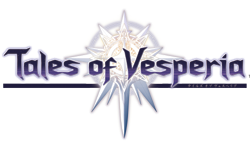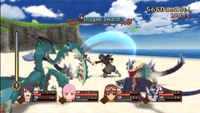|
|

|
PLATFORM
|
Xbox 360
|
BATTLE SYSTEM
|

|
INTERACTION
|

|
ORIGINALITY
|

|
STORY
|

|
MUSIC & SOUND
|

|
VISUALS
|

|
CHALLENGE
|
Adjustable
|
COMPLETION TIME
|
40-60 Hours
|
|
OVERALL

|
+ Addictive Tales combat.
+ Memorable cast of characters.
+ Great visuals.
+ Impeccable character customization.
+ Amazing crafting system.
- Virtually everything has been done before.
|
Click here for scoring definitions
|
|
|
Ten years is a long time. Wait, I think I've started a review this way already. Anyways, Namco Bandai's Tales series has now been in North America for ten years, and with this auspicious landmark, the popular franchise has made its way to the new generation of consoles with Tales of Vesperia. Featuring an upgraded version of the FR-LiMBS (Free Range Linear Motion) battle system seen in Tales of the Abyss and a fancy new graphics engine, Tales of Vesperia is a great first start to a new generation of Tales games, although the overall experience is dampered slightly by a lack of innovation.
Tales of Vesperia takes place in a world where machines known as Blastia, relics from a long-dead civilization, are used to better the quality of life. Primarily, the Blastia are used to create barriers around the cities, preventing monsters from entering. Vesperia stars Yuri Lowell (not to be confused with Yuri Lowenthal, who is a voice actor not appearing in this game), a disenfranchised ex-Knight whose ideals were trampled on by the corrupted laws of the empire. He sets out after a Blastia thief who left the capital city's poor quarter without a water source. Through his travels he meets many new friends and eventually winds up saving the world in a typical RPG fashion. Vesperia's story is not overly original and sadly makes use of the disturbing new Tales trend of respelling common words to make them "special" (fonons, anyone?) However, there can be no doubt that the cast of characters is truly excellent. Yuri is a compelling protagonist and even something of an anti-hero, and his allies all add something of their own to the mix. The villains of the game are somewhat less intriguing, with the notable exception of Zagi, whose frightening, unexplained insanity is a wonder to behold. But, as the majority of the game is spent focusing on the characters' developing relationships with each other, enhanced all the more by the massive number of fully-voiced Tales-staple skits, the less than stellar plotline can be overlooked.
The combat system also suffers from a lack of originality. For all intents and purposes, Tales of Vesperia's combat is identical to that of Tales of the Abyss. The player takes control of one character while his three allies are controlled by artificial intelligence. Normally the character only moves in a direct line, but by holding the left trigger, free run is activated and the character can be moved in any direction. What changes have been made are miniscule and have very little impact on the overall gameplay. The only significant change is the addition of Fatal Strikes. All artes, the special attacks characters can use, are marked with a red, green, or blue arrow pointing down, right, and up respectively. When several artes of one of these types is used on an enemy, a glyph may appear over them. Pressing the right trigger at this point will unleash a powerful attack that can kill any normal enemy in a single blow and deal significant damage to bosses. Unfortunately, the glyphs usually don't appear until the enemy is nearly dead, limiting their value, but as an added bonus, performing Fatal Strikes also increases the experience gained at the end of battle and even improves the drop rate for items.
 Just one of many gorgeous environments.
Just one of many gorgeous environments.
|
|
Despite being nearly identical to Tales of the Abyss, for some reason the combat doesn't feel quite as comfortable. While using artes and chaining combos has never been easier, there is a strange, awkward delay when activating free run or attempting to guard, as well as when an attack sequence finishes. This makes guarding and dodging attacks significantly more frustrating than it was in the previous games. This grievance is heightened by the increased difficulty over past Tales games, making guarding and dodging all the more important.
Outside of combat, character development is extremely robust, but, once again, incredibly unoriginal. Each character is able to wield a specific type of weapon, and from these weapons, special, usually passive skills can be learned to enhance the character's abilities. Yes, this is the same system used in Final Fantasy IX and Final Fantasy Tactics Advance. Luckily, the Tales team nailed the use of the system, as there are well over a hundred skills that can be learned, some by all characters and some specific to a particular character. These skills can have very simple effects such as improving a stat, to more powerful ones such as increasing the basic attack combo or preventing staggering while casting a spell. There are even special skills that can change an arte, creating a new "altered arte" that can be learned permanently after repeated use. Furthermore, skills are limited by Skill Points gained every level so that only so many can be equipped at a time. More powerful skills cost more points to equip, leaving the player with many tough decisions and a lot of customization options.
Accompanying the skill system is what is undoubtedly the best crafting system the series has ever had. Nearly every item in the game aside from base materials can be created through the system, and it is extremely easy to use. The items simply show up in a synthesize menu at every shop, and if the player has the materials for an item, it can be created for a nominal fee. Every enemy in the game drops a wide variety of materials for use in these recipes, and bosses, if certain conditions are met during their defeat, can even drop one-of-a-kind materials used to craft rare equipment. Finally, in a great example of user-friendliness, should a player be lacking the ingredients for a particular item, a few button-presses will reveal exactly where those ingredients can be obtained and from what enemies, assuming that they have been seen before. Players can expect to make heavy use of this crafting system, as it is vital in obtaining new weapons with new skills.
 Battles are fast, fun, and a sight to behold.
Battles are fast, fun, and a sight to behold.
|
|
The visual effects of Tales of Vesperia are top-notch. The cel-shading is quite possibly the best example of the technology to date and makes the character models look incredibly close to traditional, hand-drawn animation cels. This effect is not as noticeable in the gorgeous 3-D environments throughout the game world, but is spectacular to behold during battle and many cutscenes. Effects during combat are also impeccable. Battle animations are fluid and detailed, and artes are spectacular, particularly the colorful spell effects.
Audiophiles may find themselves a bit disappointed, however. While the voice-acting is superb, featuring the talents of well-known voice actors such as Michelle Ruff (Persona 3, Odin Sphere) and Wendee Lee (Wild ARMs 4, The Melancholy of Haruhi Suzumiya), the music is far less impressive. With a score by series staple Motoi Sakuraba, it is far from his best work, and in fact the majority of it sounds ripped directly from previous Tales games. The music is pleasant enough to listen to, but it's all been heard before. One piece does stand out however, and that is the game's fantastic theme song, "Ring A Bell", performed by Bonnie Pink.
As a Tales game, Vesperia is far more difficult than its recent predecessors. Some of the boss fights, particularly in the early portions of the game, are incredibly challenging, and players may find themselves escaping by the skin of their teeth. The boss fight provided in the demo version released on Xbox Live, as an example, is just as hard, if not harder, in the final version. As the game progresses, the difficulty eases up slightly, but regardless, it is also adjustable with three default difficulty settings and an unlockable fourth difficulty for those seeking an extra challenge. As an aside, this reviewer also encountered a rather questionable design decision that drastically increased the difficulty of the game. By completing a certain sidequest, an additional phase was added to the game's final boss fight, a phase a full seventeen levels higher than the normal final boss. Once the sidequest was completed, there was no way to beat the game without going through this additional, extremely difficult boss, and this could easily catch players off-guard and unawares.
Tales of Vesperia is a fine addition to the series and a great game in its own right, but its lack of originality and failure to do anything new are rather disappointing. While Tales of Symphonia gave the series a fresh start on the last generation of consoles, Vesperia feels like it's simply a continuation of the same old thing. With a final playtime easily exceeding fifty hours, Tales fans and fans of action-RPGs in general will definitely get their money's worth. Those who weren't impressed by Symphonia or Abyss won't find anything to change their mind here.
Review Archives
|









